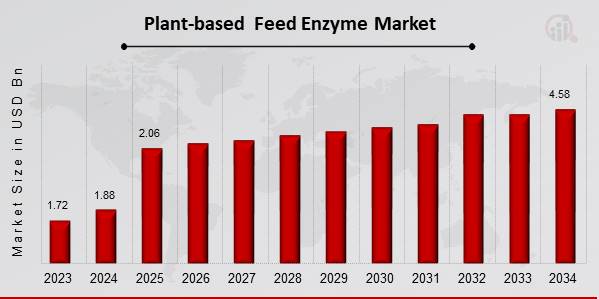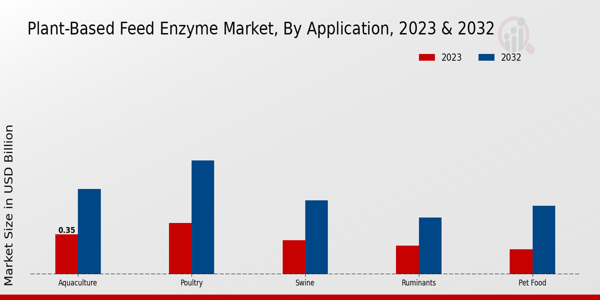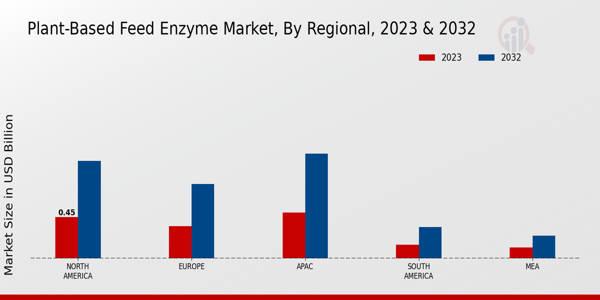Global Plant-based Feed Enzyme Market Overview
Plant-based Feed Enzyme Market Size was estimated at 1.88 (USD billion) in 2024. The Plant-based Feed Enzyme Market is expected to grow from 2.06 (USD billion) in 2025 to 4.58 (USD billion) by 2034. The Plant-based Feed Enzyme Market CAGR (growth rate) is expected to be around 9.3% during the forecast period (2025 - 2034).

Source: Primary Research, Secondary Research, MRFR Database and Analyst Review
Key Plant-based Feed Enzyme Market Trends Highlighted
The Plant-based Feed Enzyme Market is experiencing significant growth driven by various factors, including the rising demand for animal protein, increased focus on sustainability, and the need for efficient feed utilization.
As consumers become more health conscious and environmentally aware, the shift toward plant-based diets has prompted livestock producers to seek natural alternatives to synthetic additives. The regulatory push for cleaner and safer feed options further fuels this trend, while technological advancements enhance the efficacy and availability of enzyme products.
Opportunities abound in this evolving market, especially as the agriculture sector embraces innovative solutions for improving animal health and productivity. The integration of enzymes in feed formulations can lead to better nutrient absorption, waste reduction, and lower feed costs, making it an attractive choice for farmers.
Moreover, the expansion of the organic and non-GMO segments offers a growing platform for plant-based feed enzymes. Manufacturers also have the chance to innovate by tapping into emerging markets that are increasingly adopting sustainable agricultural practices and looking for eco-friendly solutions.
Recent trends highlight a surge in research and development efforts aimed at enhancing enzyme performance and tailoring products to specific animal species and their dietary needs. The market is witnessing collaborations between enzyme producers and research institutions to develop customized enzyme blends that optimize animal nutrition.
Additionally, increased digitalization within the agriculture sector facilitates better tracking and management of feed resources, promoting the use of enzymes as a vital component in smart farming practices.
As the focus on sustainability and health continues to drive the market, the future of plant-based feed enzymes appears promising, with the potential for further advancements and wider adoption across the industry.
Plant-based Feed Enzyme Market Drivers
Rising Demand for Sustainable Animal Feed Solutions
The Plant-based Feed Enzyme Market is experiencing significant growth due to the increasing demand for sustainable animal feed solutions. As consumers become more environmentally conscious, the need for products that minimize ecological impact is rising.
Feed enzymes derived from plant sources offer a more sustainable alternative to traditional feed ingredients. They are sourced from renewable resources, which helps in reducing the carbon footprint associated with animal feed production.
Additionally, these enzymes aid in improving the digestibility of feed, enhancing nutrient absorption in livestock, and minimizing waste production. This is especially relevant in the context of global initiatives aimed at reducing greenhouse gas emissions from agriculture.
The trend aligns with the overarching goal of sustainable livestock farming, pushing the Plant-based Feed Enzyme Market into a favorable position for growth over the next decade.
As governments and organizations worldwide advocate for greener practices, the market is likely to witness an influx of innovative products formulated with plant-based enzymes, reinforcing the industry's commitment to sustainability while meeting the demands of modern consumers.
As the global population continues to expand, the pressure on livestock production to meet dietary needs increases. Therefore, maximizing feed efficiency through the incorporation of plant-based feed enzymes becomes a pivotal strategy.
Moreover, with a growing focus on health and well-being, animal products derived from livestock fed with sustainable feed solutions are becoming more appealing to health-conscious consumers. Thus, the dual benefits of sustainability and enhanced feed efficiency are acting as powerful market drivers, setting a trajectory for robust growth in the Plant-based Feed Enzyme Market.
Increase in Animal Health Concerns
The Plant-based Feed Enzyme Market is driven by an increase in concerns regarding animal health and wellness. As consumers are becoming more informed about the impact of animal feed quality on livestock health, there is a shift towards using feed additives like plant-based enzymes.
These enzymes not only improve the nutritional value of feed but also promote better health in animals. Furthermore, as livestock producers aim to enhance the overall health and productivity of their animals, the demand for effective feed solutions has surged. This trend is expected to continue, further accelerating the growth of the market.
Growing Awareness of Nutritional Benefits
There is a growing awareness among livestock producers about the nutritional benefits associated with using plant-based feed enzymes. As more studies and research highlight the advantages of these enzymes in improving feed efficiency and livestock growth rates, producers are increasingly integrating them into their feeding regimens.
The recognition of these nutritional benefits is driving investment in plant-based feed enzyme products, contributing to the overall expansion of the Plant-based Feed Enzyme Market.
Plant-based Feed Enzyme Market Segment Insights
Plant-based Feed Enzyme Market Application Insights
The Plant-based Feed Enzyme Market, specifically the Application segment, is witnessing notable growth as it responds to the rising demand for sustainable and nutritious livestock and companion animal feed.
Among various applications, Aquaculture held a significant valuation of 0.35 USD billion in 2023, projected to grow to 0.75 USD billion by 2032, as aquaculture becomes more pivotal to meet global protein demands.
The Poultry segment was another major player, valued at 0.45 USD billion in 2023 and expected to reach 1.0 USD billion in 2032. This growth was largely driven by the increasing consumption of poultry products and the need for feed additives that enhance nutrient absorption and improve feed conversion ratios.
Swine, valued at 0.3 USD billion in 2023 and projected to grow to 0.65 USD billion by 2032, benefited from plant-based feed enzymes that aid in digestibility, addressing the market's push for more sustainable livestock management.
Ruminants, despite being the least dominant segment at 0.25 USD billion in 2023 and growing to 0.5 USD billion in 2032, were critical for enhancing the efficiency of fiber digestion, which was essential for their overall health and productivity.
Finally, the Pet Food segment, valued at 0.22 USD billion in 2023 and projected to grow to 0.6 USD billion by 2032, was gaining traction as pet owners increasingly prioritize quality nutrition for their animals, leading to demand for enzymes that can help improve health outcomes.
Overall, the market's growth is fueled by trends in animal health, sustainability, and the need for enhanced nutritional profiles in feed formulations. The Plant-based Feed Enzyme Market revenue derives from these applications, which continue to evolve as consumers and producers increasingly emphasize eco-friendly and health-conscious alternatives.
This segmentation showed how the industry is adapting to various feeding requirements while ensuring regulatory compliance and addressing environmental considerations, thereby providing significant opportunities for innovation and investment in this dynamic market.

Source: Primary Research, Secondary Research, MRFR Database and Analyst Review
Plant-based Feed Enzyme Market Type Insights
The Plant-based Feed Enzyme Market showcases a diverse range of types crucial for enhancing animal nutrition and feed efficiency. Within this market, enzymes such as Cellulase, Xylanase, Amylase, Protease, and Phytase play significant roles.
Cellulase is critical for breaking down fiber, allowing better nutrient absorption in livestock, while Xylanase aids in the digestion of polysaccharides, thereby improving overall feed utilization. Amylase is essential for carbohydrate digestion, and Protease focuses on protein breakdown, which are both vital for improving feed quality.
Phytase addresses phosphorus availability, a key nutrient in livestock diets. Driven by the increasing demand for sustainable animal husbandry practices and the need for improved livestock performance, the market is experiencing consistent growth.
Challenges such as the high cost of enzyme production and regulatory constraints persist, but they present opportunities for innovations and advancements in enzyme formulations. The Plant-based Feed Enzyme Market is expected to reach a value of 3.5 billion USD by 2032, reflecting robust market growth influenced by these trends and dynamics in the industry.
Plant-based Feed Enzyme Market Formulation Insights
The segment is projected to experience dynamic advancements through various formulations including powder, liquid, and granulated forms, each playing a significant role in enhancing animal nutrition and feed efficiency. The powder form is particularly favored for its ease of application and stability, while the liquid form allows for better integration into feed mixtures, making it highly convenient.
The granulated formulation provides flexibility in storage and ease of handling, contributing to its popularity among feed manufacturers. With increasing demand for sustainable and plant-based livestock products, the Plant-based Feed Enzyme Market revenue is supported by rising consumer preferences for environmentally friendly agricultural practices.
However, challenges such as production costs and regulatory compliance remain present. The market growth is further fueled by the constant need for improved livestock health and productivity. As market statistics show, the sector is expected to thrive, leveraging innovations in formulation technologies to meet evolving consumer and industry needs.
Plant-based Feed Enzyme Market Source Insights
The Plant-based Feed Enzyme Market showcases significant diversification across its Source segment, which includes Microbial, Plant, and Fungal origins. The growing emphasis on sustainable agriculture has propelled interest in these sources, as they contribute to enhancing feed quality and animal health.
Among these sources, the Microbial segment is particularly dominant due to its ability to improve nutrient utilization and digestion efficiency in livestock feed.
Plant-based sources are also becoming increasingly relevant, reflecting a shift towards more natural and sustainable feed solutions, while Fungal sources provide unique enzymes that facilitate the breakdown of complex carbohydrates, benefiting overall feed digestibility.
This segmentation not only highlights the versatility of feed enzymes but also underscores the importance of these sources in meeting the demands of modern animal husbandry practices.
Overall, the Plant-based Feed Enzyme Market statistics reflect robust growth potential, driven by advancements in enzyme technology and the rising demand for eco-friendly animal nutrition solutions. As the market continues to evolve, addressing challenges such as regulatory compliance and production costs will be critical for capturing emerging opportunities.
Plant-based Feed Enzyme Market Regional Insights
North America emerged as a significant contributor to this growth, valued at 0.45 USD billion, reflecting its majority holding in the market. By 2032, this region is expected to reach 1.06 USD billion, driven by increasing demand for sustainable feed solutions.
Europe followed closely, starting at 0.35 USD billion in 2023 and anticipated to grow to 0.81 USD billion, indicating a growing trend towards plant-based alternatives in animal nutrition. The APAC region also held substantial potential, with a valuation of 0.5 USD billion in 2023 and rising to 1.14 USD billion, capitalizing on expanding livestock production and changing dietary preferences.
South America and MEA represented smaller portions of the market, valued at 0.15 USD billion and 0.12 USD billion in 2023, respectively, but are expected to grow progressively, reaching 0.34 USD billion and 0.25 USD billion by 2032, reflecting rising awareness and investment in the plant-based feed industry.
Overall, the Plant-based Feed Enzyme Market data indicates a robust growth trajectory driven by regional demands and changing agricultural practices.

Source: Primary Research, Secondary Research, MRFR Database and Analyst Review
Plant-based Feed Enzyme Market Key Players and Competitive Insights
The Plant-based Feed Enzyme Market has witnessed significant growth due to the increasing demand for sustainable and environmentally friendly feed solutions in the animal nutrition sector. A competitive analysis within this market reveals a dynamic landscape characterized by innovation, strategic partnerships, and extensive research and development efforts.
As stakeholders focus on enhancing the nutritional value and digestibility of animal feeds, companies are increasingly investing in plant-based enzymes that offer a natural alternative to synthetic options. The rising awareness of animal welfare and the growing trend towards organic farming further propel the adoption of plant-based feed enzymes.
This evolving market is marked by the presence of several key players who leverage their technological expertise and market knowledge to gain a competitive edge.
Kemin Industries has established itself as a prominent player in the Plant-based Feed Enzyme Market, primarily due to its robust portfolio of natural solutions that cater to a diverse range of animal species.
The company is recognized for its innovative approach to enzyme development, focusing on enhancing feed efficiency and maintaining animal health. Kemin's strong commitment to sustainability aligns with the increasing consumer push towards more responsible animal husbandry practices, providing it with a competitive advantage.
Furthermore, Kemin's extensive research initiatives and continuous product improvements enable the company to address evolving market needs effectively. Its global presence and established distribution networks facilitate a broad reach in the industry, allowing Kemin to capitalize on emerging opportunities and strengthen its market position.
Alltech is another key player that significantly influences the Plant-based Feed Enzyme Market with its comprehensive range of natural feed additives. The company is known for its emphasis on science-driven innovation, which emphasizes developing proprietary enzymes that improve nutrient absorption and digestion in livestock.
Alltech's strength lies in its ability to offer tailored solutions that cater to specific animal needs, thus enhancing overall performance and farmer profitability. Additionally, Alltech has built a strong brand reputation through its commitment to quality and sustainable practices, which resonates well with consumers and producers alike.
With a rich history of research and development, Alltech continues to expand its product offerings while maintaining a focus on plant-based alternatives, further solidifying its position in the competitive landscape of the Plant-based Feed Enzyme Market.
Key Companies in the Plant-based Feed Enzyme Market Include
Plant-based Feed Enzyme Market Developments
Recent developments in the Plant-based Feed Enzyme Market have been marked by a growing interest in sustainable agricultural practices and increasing demand for animal feed alternatives. Companies like Kemin Industries and DSM are investing heavily in research and development to innovate enzyme solutions that enhance nutritional efficiency, thereby improving livestock productivity.
Alltech reported advancements in fermentation technology, aligning with the trend of natural additives in animal nutrition. In current affairs, Syngenta and Ginkgo BioWorks are collaborating on developing bio-based solutions that utilize plant-derived feed enzymes, underscoring the shift towards environmentally friendly products.
In terms of market dynamics, Novozymes and BASF have been focusing on strategic partnerships to expand their product ranges and market presence, while DuPont and Advanced Enzymes are exploring novel applications for their enzyme products in feed.
Recently, Merck KGaA announced an acquisition of a smaller enzyme producer, enhancing its portfolio in this sector. As these companies bolster their growth strategies, market valuations are rising, reflecting an optimistic outlook for the plant-based feed enzyme sector, driven by innovation and sustainability initiatives across the industry.
Plant-based Feed Enzyme Market Segmentation Insights
-
Plant-based Feed Enzyme Market Application Outlook
-
Plant-based Feed Enzyme Market Type Outlook
-
Plant-based Feed Enzyme Market Formulation Outlook
-
Plant-based Feed Enzyme Market Source Outlook
-
Plant-based Feed Enzyme Market Regional Outlook
| Report Attribute/Metric |
Details |
| Market Size 2024 |
1.88 (USD billion) |
| Market Size 2025 |
2.06 (USD billion) |
| Market Size 2034 |
4.58 (USD billion) |
| Compound Annual Growth Rate (CAGR) |
9.3% (2025 - 2034) |
| Report Coverage |
Revenue Forecast, Competitive Landscape, Growth Factors, and Trends |
| Base Year |
2023 |
| Market Forecast Period |
2025 - 2034 |
| Historical Data |
2019 - 2023 |
| Market Forecast Units |
USD billion |
| Key Companies Profiled |
Kemin Industries, Alltech, Fermenta Biotech, EMF Innovations, Ravago, Syngenta, Ginkgo BioWorks, Angus Chemical, Novozymes, DSM, BASF, DuPont, Advanced Enzymes, AB Enzymes, Kraft Foods |
| Segments Covered |
Application, Type, Formulation, Source, Regional |
| Key Market Opportunities |
Rising demand for sustainable agriculture, Increasing livestock production globally, Growth in organic farming practices, Technological advancements in enzyme formulations, Expansion in aquaculture feed applications |
| Key Market Dynamics |
Rising demand for sustainable agriculture, Increasing livestock production and consumption, Regulatory support for natural additives, Growing awareness of feed efficiency, Shift towards plant-based diets |
| Countries Covered |
North America, Europe, APAC, South America, MEA |
Frequently Asked Questions (FAQ) :
The Plant-based Feed Enzyme Market is expected to be valued at 4.58 USD billion in 2034.
The expected CAGR for the Plant-based Feed Enzyme Market from 2025 to 2034 is 9.3%.
The Poultry application segment is projected to reach 1.0 USD billion in value by 2034.
The Aquaculture application segment was valued at 0.35 USD billion in 2023.
North America is expected to have the largest market share, valued at 1.06 USD billion by 2034.
The Ruminants application segment is expected to be valued at 0.5 USD billion in 2034.
Key players in the market include Kemin Industries, Alltech, and Novozymes among others.
The Pet Food application segment is expected to reach a market value of 0.6 USD billion by 2034.
The Europe region was valued at 0.35 USD billion in 2023.
The Swine application segment is projected to be valued at 0.65 USD billion in 2034.

















